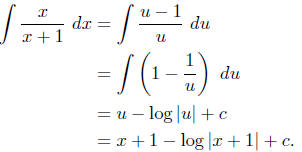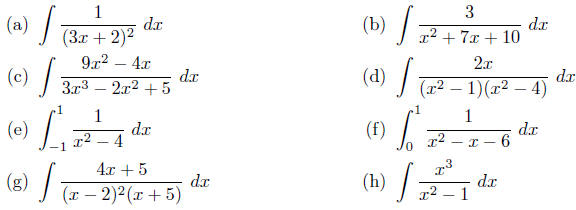Integration of Rational Functions
In this section we will take a more detailed look at the
use of partial fraction decomposi -
tions
in evaluating integrals of rational functions, a technique we first encountered
in the
inhibited growth model example in the previous section. However, we will not be
able to
complete the story until after the introduction of the inverse tangent function
in Section
6.5.
We begin with a few examples to illustrate how some integration problems
involving
rational functions may be simplified either by a long division or by a simple
substitution.
Example To evaluate  , we first perform
a long division of x + 1 into x2 to
, we first perform
a long division of x + 1 into x2 to
obtain

Then

Example To evaluate
 , we make the substitution
, we make the substitution

Then

Example To evaluate
 , we perform a long division of x + 1 into x to obtain
, we perform a long division of x + 1 into x to obtain

Then

Alternatively, we could evaluate this integral with the
substitution
u = x + 1
du = dx.
With this substitution, x = u − 1, so we have

Note that this is the same answer we obtained above,
although with a different constant
of integration.
Partial fraction decomposition: Distinct linear factors
Now we consider the general problem of evaluating

where both f and g are polynomials. We will assume that
the degree of g is less than the
degree of f. As illustrated in the first and third examples above, if this is
not the case,
we can first perform a long division to simplify the quotient into the form of a
polynomial
plus a remainder term which is a rational function with numerator of degree less
than the
denominator. To begin we will suppose that g factors completely into n distinct
linear
factors. That is, suppose there are constants  and
and  such that
such that

where the factors on the right are all distinct. From a
theorem of linear algebra, which we
will not attempt to prove here, there exist constants
 such that
such that

The expression on the right of (6.4.2) is called the
partial fraction decomposition of
![]() .
.
Once the constants  are determined, the evaluation of
are determined, the evaluation of

becomes a routine problem. The next examples will
illustrate one method for finding these
constants.
Example To evaluate  , we need to find
constants A and B such
, we need to find
constants A and B such
that

Combining the terms on the right, we have

Now two rational functions with equal denominators are
equal only if their numerators are
also equal; hence we must have
1 = A(x − 3) + B(x − 2)
for all values of x . In particular, for x = 2 we obtain
1 = −A,
from which it follows that A = −1, and for x = 3 we have
1 = B.
Thus

so

Example To evaluate
 , we need to find constants A and B such
, we need to find constants A and B such
that

Combining the terms on the right, we have

As before, it follows that
3x = A(2x − 1) + B(x + 5)
for all values of x. In particular, for x = −5 we obtain
−15 = −11A,
from which it follows that

and for  we have
we have

from which it follows that

Hence

so

Partial fraction decomposition: Repeated linear factors
Returning to the general problem of evaluating
![]()
where f and g are both polynomials and the degree of f is
less than the degree of g,
we will now consider the case where g factors completely into linear factors,
allowing for
the possibility that one or more of these factors may be repeated. Specifically,
suppose
the factor ax + b occurs n times in the factorization of g. Then the partial
fraction
decomposition of  must contain a sum of terms of the form
must contain a sum of terms of the form

for some constants
![]() , in addition to
similar terms for every other factor of g.
, in addition to
similar terms for every other factor of g.
This is best illustrated in an example.
Example To evaluate  , we need to find
constants A, B, C, and D
, we need to find
constants A, B, C, and D
such that 
That is, this partial fraction decomposition contains
three terms corresponding to the
factor x−1, since it is repeated three times, and only one term corresponding to
the factor
x − 2, since it occurs only once. Moreover, the degrees of the denominators of
the terms
for x − 1 increase from 1 to 3. Now combining the terms on the right of (6.4.4),
we have

Again, it follows that

for all values of x. However, because of the repeated
factors, we cannot choose values for x
which will isolate each of the constants one at a time as we did in the previous
examples.
Instead, we will illustrate another technique for finding the constants. By
multiplying out
(6.4.5) and collecting terms, we obtain

for all values of x. Since two polynomials are equal only
if they have equal coefficients, we
can equate the coefficients of x + 1 with the coefficients of the polynomial on
the right to
obtain the four equations

From the first equation we learn that
D = −A.
Substituting this into the second equation gives us
B = A.
Substituting both of these values into the third equation results in
C = A + 1.
Finally, substituting for D, B, and C in the fourth equation gives us
−2A + 2A − 2(A + 1) + A = 1,
which gives us A = −3. Hence B = −3, C = −2, and D = 3. Thus

Note that in solving for A , B, C, and D, we could have
first substituted x = 1 and x = 2
into (6.4.5) to obtain values for C and D, respectively. These values could have
then been
used to simplify (6.4.6) before solving for A and B.
The Fundamental Theorem of Algebra states that every polynomial factors into a
product of linear factors and irreducible quadratic factors ; hence, to complete
the story of
integrating rational functions, we need to consider the case where the
factorization of the
denominator includes irreducible quadratic factors. However, we will learn in
Section 6.5
that for an irreducible quadratic polynomial g,

involves the inverse tangent function. Thus we need to
discuss the inverse trigonometric
functions before continuing the story of integrating rational functions.
Problems
1. Evaluate each of the following integrals.

2. Evaluate each of the following integrals.

3. Evaluate each of the following integrals.


4. Evaluate each of the following integrals.

5. Solve the differential equation

using the method used to solve the logistic differential
equation in Section 6.3. Assume
x(0) = 0 and −1 < x(t) < 1 for all t.
| Prev | Next |